For the United States, China’s widening presence in Latin America has been much more than a minor nuisance in its geopolitical backyard.
US Secretary of State Mike Pompeo warned on a tour of the region in April that “predatory” lending practices and other “malign or nefarious” behaviour by Beijing had injected “corrosive capital into the economic bloodstream, giving life to corruption and eroding good governance”.
As the Americans see it, Chinese companies are harming Latin America by investing mostly in the extraction and transportation of its precious raw materials. This, they say, has led to a greater dependence on commodities as opposed to US companies which focus on manufacturing and services.
Many in Latin America share these concerns, but for others the difference between the long-standing American influence and the growing Chinese role is not so black and white.
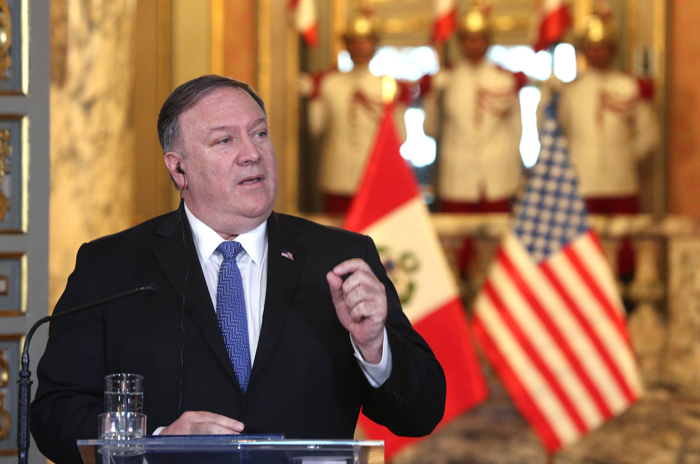
US Secretary of State Mike Pompeo toured four Latin American countries – Peru, Chile, Paraguay and Colombia – in April 2019. Photo: AP

Chinese President Xi Jinping welcomes his Venezuelan counterpart Nicolas Maduro to Beijing before their talks in September 2018. Photo: Xinhua
The Middle Kingdom may be seen as a 21st century coloniser, but it has also presented alternative investment options. The main problem, some argue, is that local governments across the continent have not been able to take full advantage.
Latin America has for centuries grappled with different forms of foreign influence. The grievances and wounds created by hundreds of years of Spanish and Portuguese rule are today still present in the collective psyche, despite formal foreign control ending more than a century ago.
The US then quickly became the hegemonic power, but its strategic control has been hard to sustain over the past two decades, partly because of China, whose growing economy has driven up demand for commodities.
Trade between China and Latin America has surged, from US$12 billion in 2000 to almost US$306 billion last year, and China has become a major investor. The value of its loans – mostly for energy and infrastructure projects – has surpassed financing from the World Bank and Inter-American Development Bank.
But America and international financial institutions say transparency is lacking and the recipients of these loans face growing debt traps.
Others bristle at what they see as attempts by China to leverage its newfound economic power for geopolitical gain. In recent years several nations, including Panama and the Dominican Republic, have severed diplomatic ties with Taiwan, which Beijing views as a renegade province.
LOCAL BACKLASH
The importance of the region was acknowledged last year when Beijing invited Latin American and Caribbean countries to join its ambitious Belt and Road Initiative – a global trade strategy that aims to expand economic links through ports, roads, airports, pipelines and other infrastructure projects.
China’s foothold can also be seen on the streets of cities across the region. In Ecuador, a country of more than 16 million which some say has been a laboratory for Sino-Latin American investment, Chinese characters can be found sewn into the white covers on seat headrests inside new long-distance buses.
CHINESE-BACKED PROJECTS IN LATIN AMERICA
CHINESE-BACKED PROJECTS IN LATIN AMERICA
In the capital, Quito, Chinese-made CCTV cameras are perched on street corners and inside buildings. The devices have been installed across the country since 2011, when Ecuador introduced a monitoring system to public spaces that includes facial recognition technology.
According to the local authorities, the system has proved a powerful tool in combating crime, but experts suggest the images captured have also been used for surveillance and intelligence gathering.
The adoption of Chinese technology elsewhere on the continent has given rise to similar human rights concerns.
Bolivia in the past two years launched an “emergency response system” developed by a Chinese company and financed with a loan from Beijing.
Venezuela, also using Chinese tech, introduced its “fatherland card” in 2016, an identity document human rights activists fear will be used for surveillance or to infringe on privacy.
But the Chinese presence in Latin America goes deeper, with the focus largely on extracting natural resources and infrastructure.
Dams and hydroelectric power plants are being built by Chinese companies in the Amazon rainforest and Patagonia. Thousands of kilometres of rail track are being laid in Brazil, Peru and Venezuela. China and Argentina are negotiating over construction of a US$8 billion nuclear facility in the province of Buenos Aires.
Despite many of these projects having been met with opposition from locals, Chinese interest in the region shows no sign of slowing.
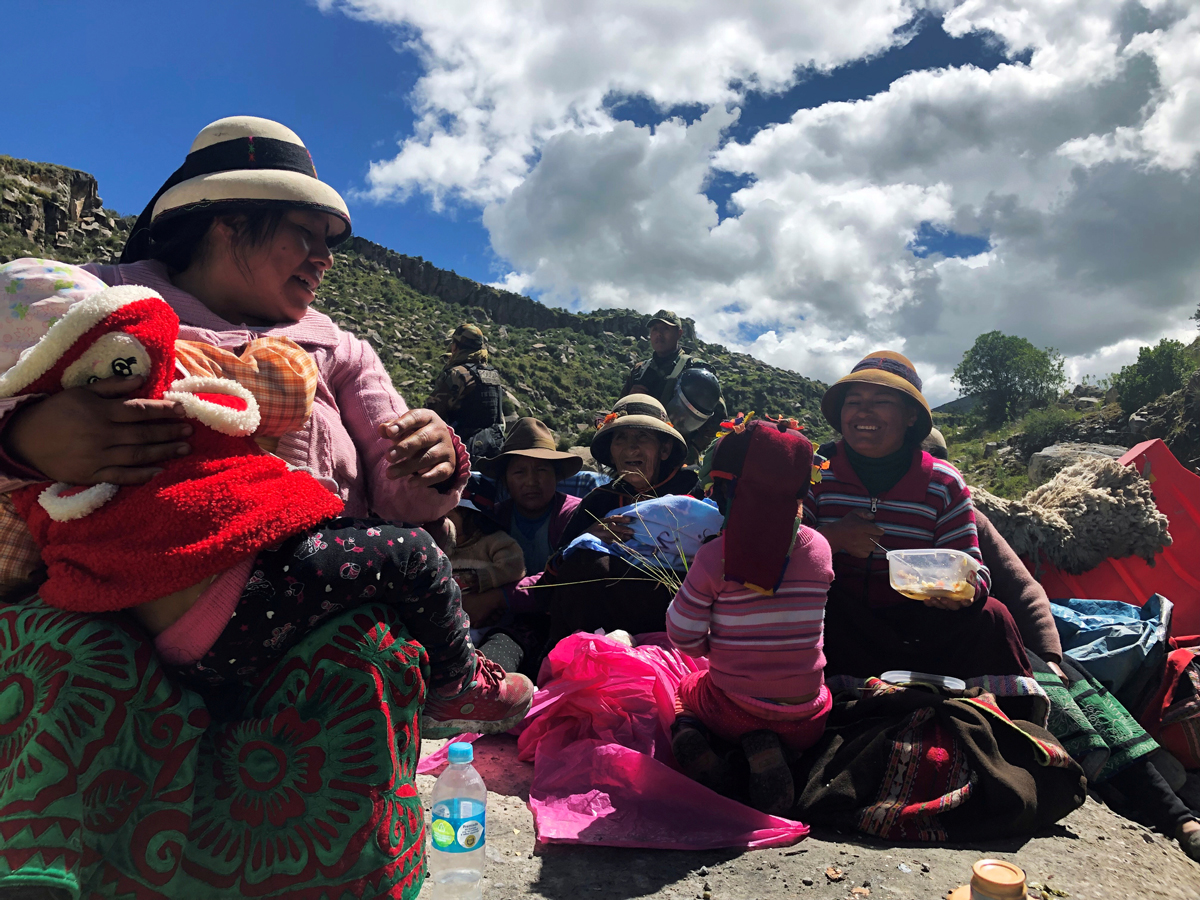
Protesters block the road to the Las Bambas copper mine during a protest against Chinese mine operator MMG Ltd in Fuerabamba, Peru, in March 2019. Photo: Reuters
“We have found most projects in Latin America have faced a local backlash because of environmental concerns about pollution and harm to residents and livelihoods,” Argentinian scholar Ariel Armony and Mexico-based researcher Enrique Dussel Peters wrote in an essay published last year. The pair, along with Shoujun Cui – director of the Research Centre for Latin American Studies at Beijing’s Renmin University – produced the book Building Development for a New Era: China’s Infrastructure Projects in Latin America and the Caribbean.
“For example, there have been concerns about the environmental impact of Sinopec’s oil refineries in Moín, Costa Rica. The national secretary of the environment objected to the first evaluation for serious omissions,” Armony and Peters wrote, referring to China’s state-owned oil and gas enterprise. “The beginning of construction for the Condor Cliff and La Barrancosa hydroelectric dams in Santa Cruz, Argentina, without an environmental impact assessment, led to the Argentine Supreme Court ordering the suspension of the projects.”
NO DIALOGUE
Carolina Viola, a researcher with the Latin American School of Social Sciences in Ecuador, acknowledges these concerns, and questions whether the region’s role in Chinese empire building is “that different to being part of the ‘gringo’ empire” – referring to the US.

Police officers stand guard outside the Episcopal Conference of Peru in April 2019, the site of negotiations between the Fuerabamba community, Chinese mine operator MMG Ltd, the Peruvian government and the Catholic church.
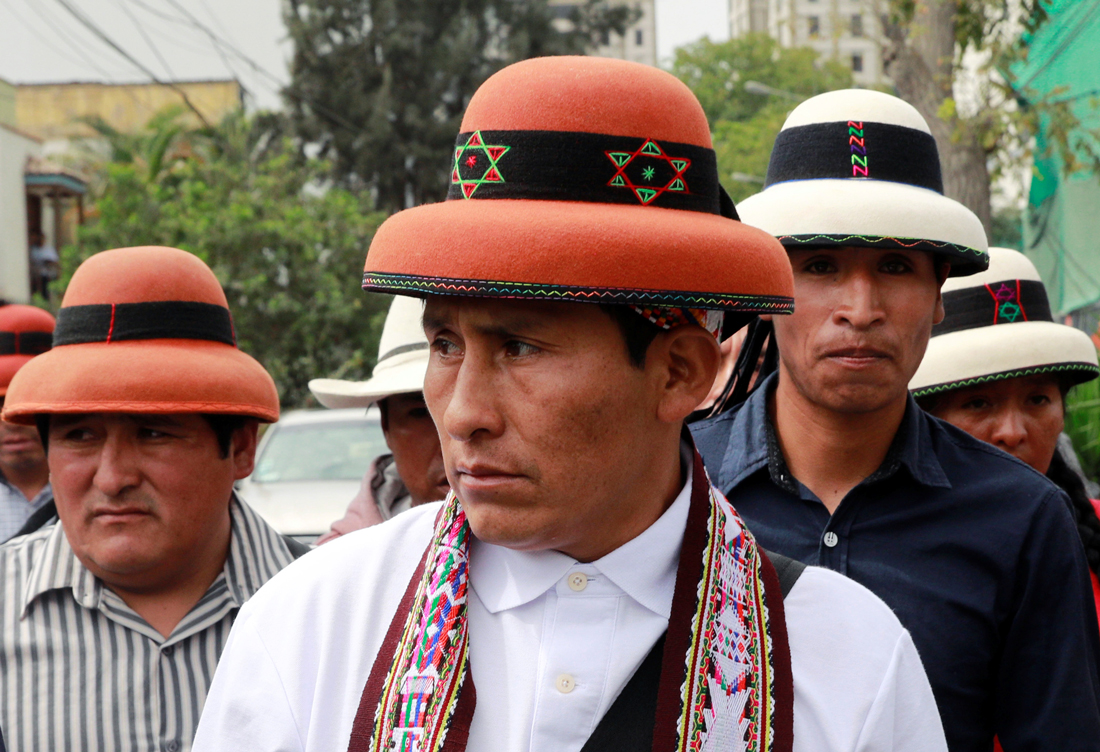
Gregorio Rojas, president of the Fuerabamba community, arrives to take part in negotiations aimed at ending a dispute with the indigenous community that blocked roads to MMG Ltd’s Las Bambas mine. Photos: Reuters
“There’s a perception that these new investments should have more of a positive connotation because they are done between governments and not using ‘gringo’ or imperialist capital. But the input from the community isn’t saying that,” she says.
Viola, who has closely studied several Chinese-backed projects on the continent, says Chinese companies have made little effort to interact with their hosts.
“For Chinese companies, the community is not a valid interlocutor, only the government is. The difference is that gringo imperialism deals with civil society, the Chinese don’t … They don’t try to understand where they are,” Viola says. “And they consider that social peace is not their problem.”
She also argues these companies do not have high environmental standards and labour rights are not observed. “They follow a corrupt pattern … and the logic of ‘Chinese for Chinese’ prevails.”
Po Chun Lee, a Taiwanese-Ecuadorean economist and scholar based in Quito, says Chinese investment is a new option for Latin America to turn to in finding solutions for its myriad problems – but it comes with a price.
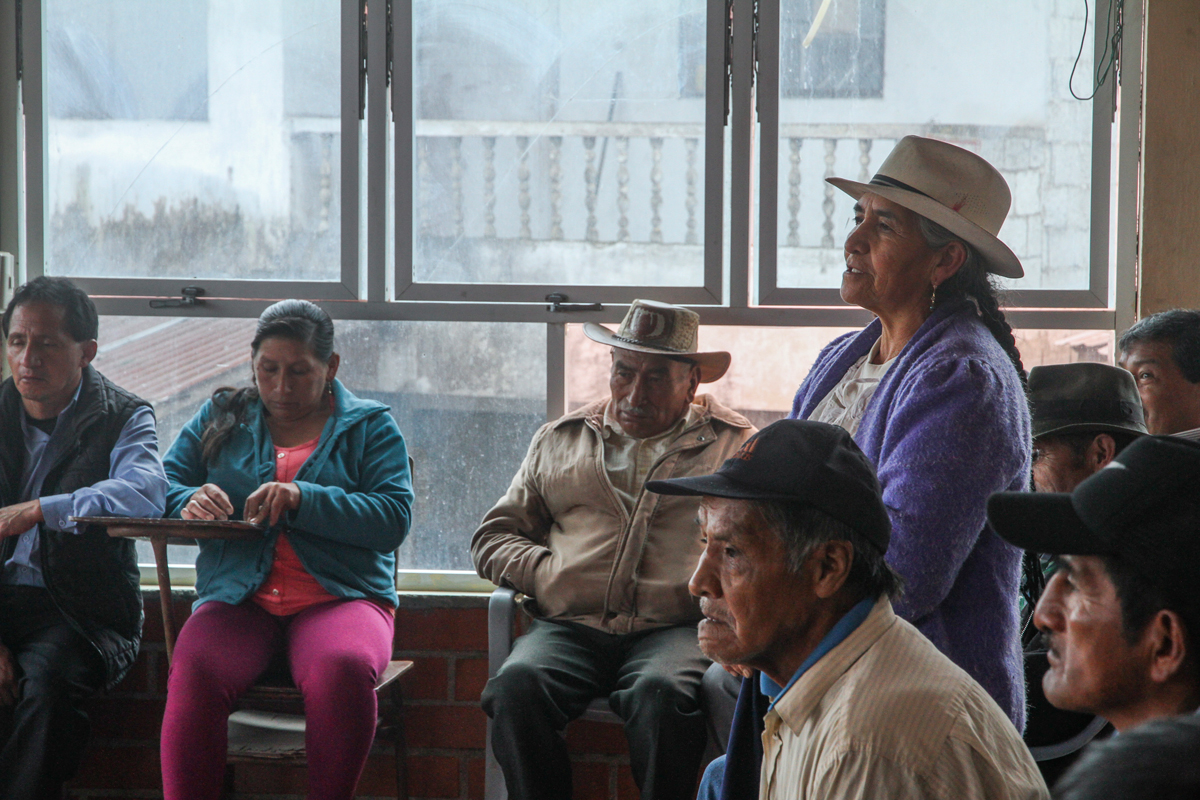
Residents of Molleturo, Ecuador, gather to discuss strategies of resistance against the Rio Blanco mining project, which is operated by a Chinese-owned company. Photo: Raquel Carvalho
“Where we do get problems is when we think about international standards,” he says.
“Wherever China invests, they make it very Chinese. They don’t consider the local culture. For example, they bring Chinese chefs to cook on their settlement. They separate or segregate the workers – like there’s a Chinese camp and local camp. I think China has a lot do in this regard.”
Natalia Yépez, a lawyer with the Ecumenical Human Rights Commission of Ecuador who has worked on several cases involving alleged rights infringements against local residents by Chinese companies, says a lack of communication is a major issue.
“It’s unclear to us how to approach these companies, who to talk to or even which international mechanisms can be used to address these problems ... We don’t even have access to the Chinese embassy in Ecuador,” Yépez says of the silence rights groups have encountered when attempting to contact Beijing’s diplomatic mission.
ECONOMIC BOOST
But Armony and Peters say the evidence does not support accusations that Chinese loans or businesses are detrimental to political or economic development.
“The investment fills a crucial gap in infrastructure needed for the region while establishing a new ally that will help further their economies and standing on the global stage,” the pair argue.
The benefits of accepting Chinese capital are wide-ranging, others say.
“China is one of the few countries in the world that can do the whole package. They can finance you and build the project for you. Not many countries can do that. In that sense it’s good because they can reduce the costs, especially for emerging countries,” economist Lee says.
CHINESE LOANS BY COUNTRY
“If you go to the IMF [International Monetary Fund] or the World Bank, they have their conditions. They lend you a billion dollars and you still have to contract with their partners. China does the same, but there’s a huge difference,” Lee says. “They don’t have this conditionality problem – they don’t tell you: ‘Change your political economy to make it look more neoliberal or something that resembles the Washington consensus.’ In that sense, it’s a step forward, because there are no political conditions for those loans.”
Alexander Main, director of international policy at the Centre for Economic and Policy Research in Washington, says US officials are largely powerless to prevent the shift to Chinese financing.
“China, by not imposing policy prescriptions in its commercial and financial dealings, provides its Latin American partners with policy space to advance their own economic and political alternatives, including ‘state-led’ practices that clash with the US agenda,” he wrote in an essay last year.
Although US officials are “sounding increasingly menacing vis-à-vis the Chinese ‘threat’ … there is little they can really do to halt China’s inexorable advance”, Main says.
Growing US discomfort comes as no surprise, Renmin University scholar Cui concludes. “What China gains in Latin America will be the United States’ loss,” he says.
“From the Latin American perspective, it is very beneficial both in terms of economic growth and also in terms of creating jobs … Latin America has become an increasing priority for China and there is a lot of room for cooperation.”
THE NEWCOMER
Ninety per cent positive and only 10 per cent negative – that is Cui’s verdict on China’s investments in Latin America.
“These companies, compared to their peers such as the Americans or Japanese, are newcomers when it comes to overseas ... There is a learning curve,” he says.
“It is true some have made mistakes and they have their flaws … It will take some time for them to become aware of the need to protect the environment, follow local laws and interact with communities. But they are learning and their operations are improving ... It’s not fair to ignore the positive side of it.”
He says China has treated Latin American countries as equal partners and “does not meddle in their internal politics or try to control the local economy”.

Argentinian President Mauricio Macri visits a Buenos Aires cold storage plant in April 2019 to announce that his country will begin exporting pork to China. Photo: AP
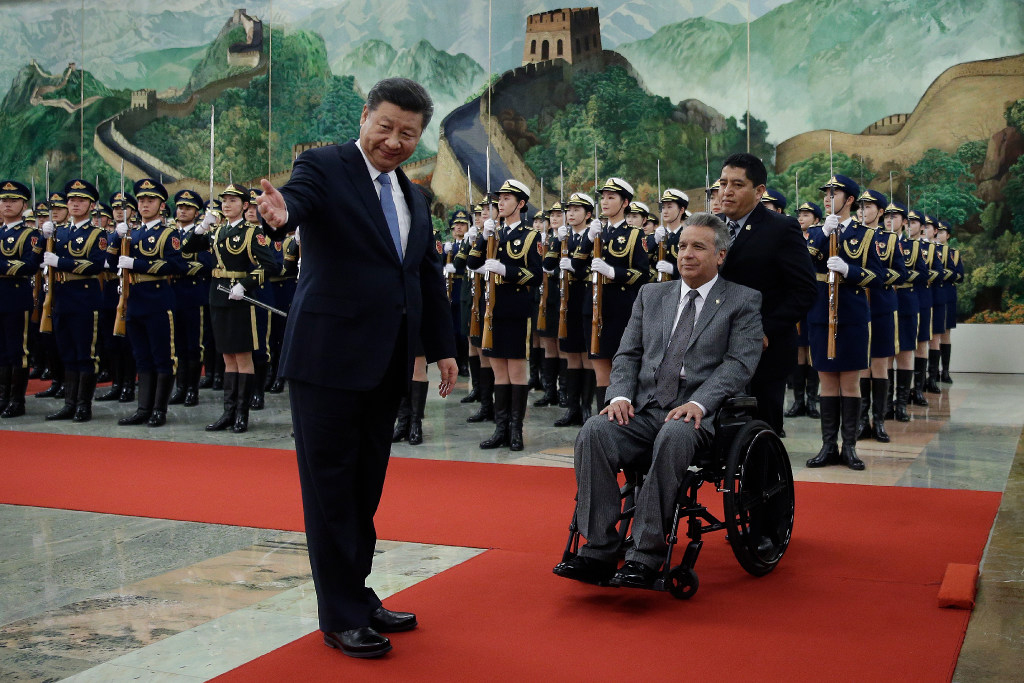
Ecuador's President Lenin Moreno with Chinese President Xi Jinping at Beijing’s Great Hall of the People in December 2018. Photo: AP
Milton Reyes, a professor and researcher with the Institute of Higher National Studies of Ecuador, says Chinese cash presents both an alternative and “relative autonomy”.
“It’s a better option in the Ecuadorean context over North American interference,” he says. “Yes, we are in debt, but there is technological development and it’s still cheaper than if we had to deal with international institutions.”
Many of the failures involved in Chinese projects are actually the responsibility of local authorities, he argues. “Building schools and community centres is the government’s responsibility ... The obligation of the companies is to pay their taxes, and the government should do the rest.”
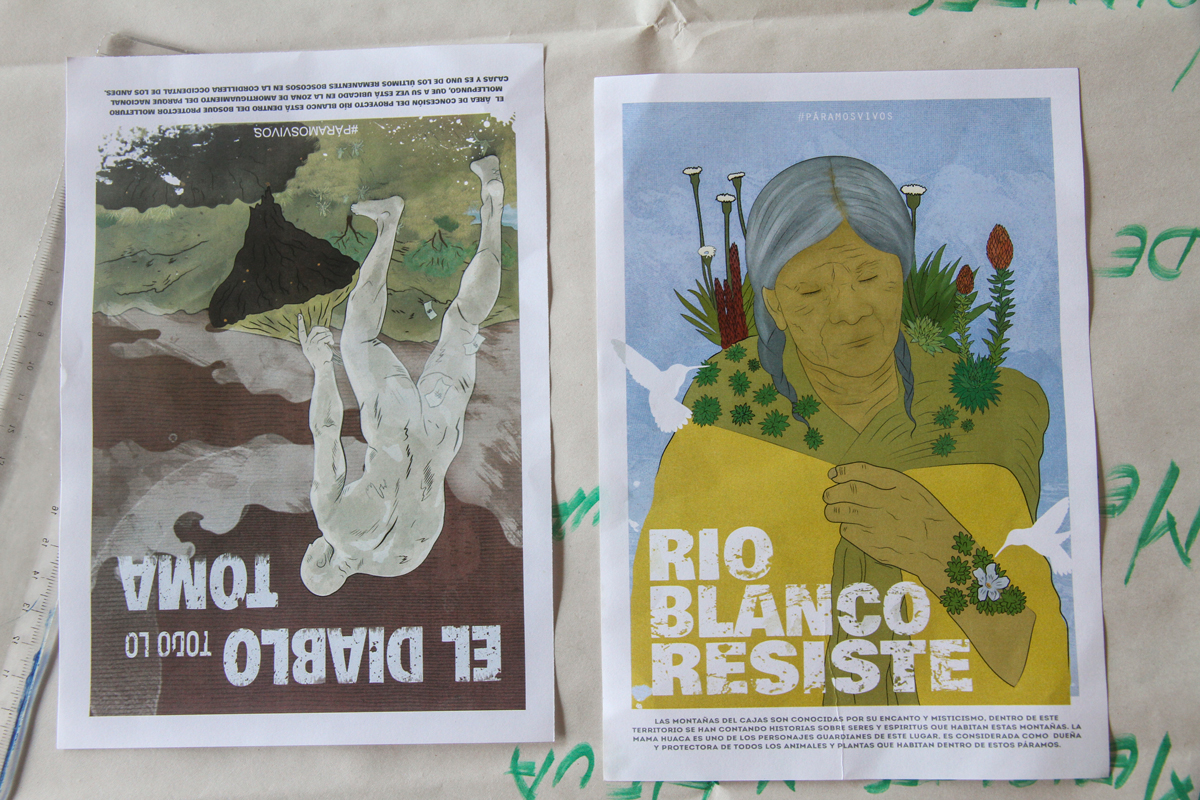
The poster on the right reads “Rio Blanco resists”, referring to the local community’s fight against a Chinese-backed mining project in Ecuador. Photo: Raquel Carvalho
Reyes also says blame goes both ways, with authorities knowing little about Chinese culture, which leads to an inability to effectively negotiate with the foreign investors.
At the same time, “many non-governmental organisations here have a very negative view of Chinese investment. They see these investments as predatory. And that has a lot to do with a Eurocentric vision that is still very ingrained in Latin America,” he says. “Here, the ideal is still the Western world.”
Sofía Jarrín, coordinator of the Collective on Chinese Financing and Investments, Human Rights and the Environment in Latin America, brushed off the idea that advocacy groups are targeting the Chinese. The organisation – which includes several non-profit groups on the continent – submitted a report to the United Nations last year that claimed 18 Chinese-backed mining, oil and hydroelectric projects had systematically violated human rights in five Latin American countries.
“There is a certain construction of the ‘yellow threat’ as the new public enemy, which is very much the US agenda. But that is not our approach,” she says.
“China arrived in Latin America at a time when the countries needed to diversify their economy. Our argument is that there needs to be a clear set of rules ensuring these financial entities and companies respect human rights and the environment.
“We don’t see China as a public enemy, but we want to create structures that guarantee certain standards are followed.”
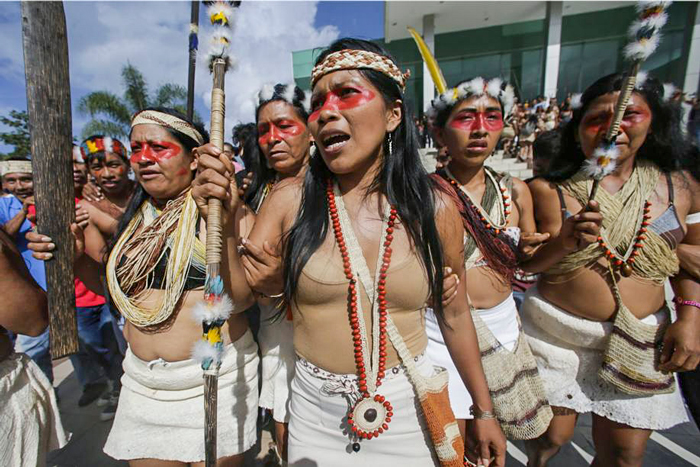
Waorani indigenous people in Ecuador protest against the exploitation of oil in their territory. Photo: AP
Beijing has been given “preferential conditions” in countries such as Ecuador, including security guarantees that could jeopardise national sovereignty, she adds.
In March this year, China agreed to 284 recommendations for upholding human rights in its international investments. The orders were issued as part of the UN Human Rights Council’s Universal Periodic Review. The country now has about four years to take steps to ensure that development and infrastructure projects within and outside its territory are fully compatible with human rights obligations and respect the environment.
But for people such as Taish Mercedes, 65, part of the Shuar minority, who are indigenous to Ecuador and Peru, there is little difference between Chinese, American or any other foreign source of investment.
Her home was bulldozed by the local government to make way for a Chinese-backed mining project in the Ecuadorean region of the Amazon basin.
“Our motherland can provide us with everything. That is our way of life. But the colonisers came and taught people how to live with money. Many became greedy,” she says, describing the impact of the Spanish.
“Now the Chinese are the new colonisers – just like the ones before. They are ruining the harmony of our land.”
Continue reading Chapters 2 and 3, about the impact of Chinese investment in Ecuador.